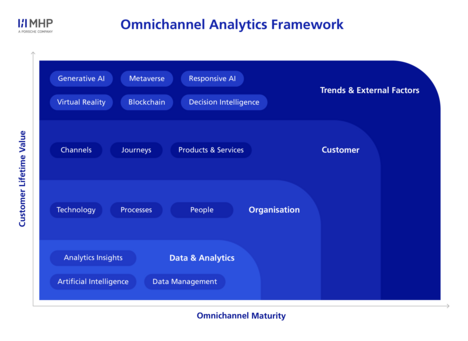
- Blog, Customer Experience & Sales
- Published on: 23.01.2024
- 11:19 mins
How to Create a Seamless Customer Journey With Omnichannel Analytics
Constantly changing purchasing behaviors and rising customer expectations are driving innovation in omnichannel management. Customers now use a variety of information and shopping channels – they want greater autonomy, and they expect a seamless shopping experience as well as a customer journey with a personal touch.
Within this context, innovative trends in omnichannel analytics – in particular data-driven AI approaches such as attribution modeling and generative AI – are attracting more and more interest. These approaches offer new opportunities to make the omnichannel strategy even more customer-centric and effective. The aim is to achieve a 360-degree view of the customer and to create the perfect omnichannel experience for the customer.
The omnichannel retail solutions market is poised for impressive growth, with a projected value of USD 13.5 billion by 2028. This marks a substantial CAGR of 13.4% throughout the forecast period. Companies that have yet to implement a seamless omnichannel strategy that interconnects diverse sales channels, delivering a unified customer experience across multiple touchpoints, may experience a significant sales decline of approximately 10-30%. Finding a comprehensive omnichannel approach is however complex and can be hugely challenging for many companies. The key lies in omnichannel analytics. This advanced approach aims to capture and analyze omnichannel data, which in turn allows for the development of a customized omnichannel solution that maximizes customer loyalty and customer satisfaction.
This article explains how you can benefit from the advantages of omnichannel analytics. We will also take a closer look at the technical aspects of omnichannel analytics, including composable tech platforms, attribution modeling, and explainable AI. In addition, we will look at how MHP can support you in implementing omnichannel analytics in your company.
Taking the Omnichannel Approach to Create a Cross-Channel Customer Journey
Companies only have a limited amount of resources. As such, maximizing the use of available resources is essential for business success. This is especially true in departments with a strong customer focus, such as sales and marketing. Omnichannel analytics collects and analyzes information from various sales and communication channels so complex data volumes can be analyzed. This provides a comprehensive picture of how customers interact with your company and where it makes most sense to allocate resources.
“Omnichannel” or “omnichannel commerce” refers to the linking of all channels, such as retail stores, online shops, mobile apps, and more. Omnichannel analytics allows companies to track their customers’ behavior across all channels. As such, omnichannel analytics allows you to create a uniform and consistent customer experience.
Omnichannel Analytics – Good for Customers and Companies
One of the main goals of omnichannel analytics is to improve the customer journey. An optimal customer experience is characterized by…
- …personalized offers: Companies understand the needs of customers and can tailor promotions and offers to each individual buyer.
- …seamless customer experience: Linking different touchpoints allows for the smooth transfer of interactions from one channel to another.
- …targeted real-time responses: Companies can respond directly to customers and can, for example, send them instant notifications about the latest offers.
Benefits to the customer have an indirect positive impact on the success of the company as a whole. But omnichannel analytics also provides plenty of direct benefits to your business:
- More effective marketing strategies: Omnichannel analytics enables companies to develop data-driven marketing strategies based on customers’ real-time behavior.
- Higher return on investment (ROI): Resources can be deployed more accurately with omnichannel analytics, which increases ROI.
- Improved customer satisfaction: Personalized and seamless omnichannel experiences increase customer satisfaction and customer loyalty.
- Reduced costs: Business processes can be optimized and costs saved thanks to the insights gleaned from omnichannel analytics.
- Predictable trends: Thanks to predictive analytics, you can recognize trends at an early stage for greater flexibility when it comes to planning offers and marketing strategies.
- Improved products and services: Gain insights into your customers’ preferences, expectations and experiences, and use these findings to optimize your company’s performance.
- A clear competitive advantage: With omnichannel analytics, you can respond quicker to market changes and offer a superior customer experience across multiple channels.
In short, omnichannel analytics helps you to achieve your primary goal: to create a comprehensive 360-degree view of your customers to fully understand their needs and preferences. These in-depth insights give you the information you need to specifically target your business activities and respond successfully to your customers’ requirements.
How to Implement Omnichannel Analytics and Data-Driven Customer Journeys
Do you want to optimize the customer journey and provide shoppers with the best possible buying experience across multiple channels? Companies need to move away from small-scale silo thinking and look to implement omnichannel analytics. Yet, despite the fact that many companies are currently in the midst of a digital transformation, combining these new methods with a comprehensive omnichannel commerce strategy remains a major hurdle. Decision-makers often hesitate due to uncertainties concerning the feasibility of the approach, data protection, and economic viability.
The challenge: keeping pace with customers’ growing requirements
Customer requirements are evolving rapidly, especially in technology-driven sectors such as the automotive industry. Yet companies often don’t have a reliable starting point when it comes to implementing omnichannel analytics. Decision-makers often find themselves grappling with the following questions:
Which data sources should we use?
How do we overcome data silos?
What impact would omnichannel analytics have on how different departments are managed?
How can we combine data from different channels?
The opportunity: analyzing the customer journey with AI
Data-driven customer journeys utilizing artificial intelligence (AI) are able to support companies in this challenge. This is because AI uses a 360-degree view of customer behavior to record, interpret and predict their actions with regard to multiple communication channels and product offers. At the same time, AI enables the implementation of hyper-personalized search results that take customers’ individual preferences into account. For this to work, however, a number of requirements must be met.
The solution: an omnichannel strategy with a clear vision
An omnichannel strategy needs clear ideas and objectives that link the various departments and their databases. Without this pooling of knowledge, investments will have a scattergun approach and the desired results won’t be achieved. The following three core aspects should form the basis for all steps to ensure successful implementation:
- Organization
- Customer
- Data & analytics
Organization: At the organizational level, an analysis is performed on the existing technical infrastructure and established processes within the company. The human factor is also considered here; namely in the form of the question: Does your corporate culture have a data-driven mindset or is comprehensive change management required to establish new processes?
Customer: What are your target audience’s pain points? Which products do they need? Which channels are used to reach customers and what would an optimal omnichannel customer journey look like?
Data & analytics: Strategic data management, the continuous analysis of KPIs to generate relevant and ongoing insights, and – as already mentioned – the use of the latest AI tools and solutions are all essential for omnichannel and customer journey analytics.
A Top-Level Technological Solution – Integrating Omnichannel Analytics with MHP
When it comes to the technical implementation of omnichannel analytics, there is no one correct method: Technological solutions should be individually tailored to the requirements of your company to ensure a successful implementation. Despite this, there are three important aspects that form the basis for approaches to omnichannel analytics. These are presented below:
- Composable tech platforms
- Attribution modeling
- Explainable AI
Composable tech platforms
A composable tech platform consists of autonomous components that you can select as required to meet your company’s needs. This allows you to efficiently integrate and orchestrate various software applications, services, and tools.
With an agile and adaptable IT environment, you can react quickly to changing circumstances without being restricted by a monolithic software system. The benefits?
Thanks to the linking of different technologies, data sources and applications via composable tech, you can effectively search for information across all company channels and then analyze it.
Customized analysis tools and dashboards can be created to monitor and process specific omnichannel metrics thanks to the modular software structure.
You can scale your omnichannel analytics capabilities according to the growing needs and scope of your business, and can keep pace with increasing data volumes and more complex requirements.
A flexible infrastructure also means that you can dynamically integrate methods, tools, and technologies that are important for omnichannel analytics into your company – for example, AI-driven approaches such as attribution modeling and explainable AI.
What is attribution modeling?
Attribution modeling is an omnichannel approach that is used to evaluate the value and impact of different marketing and advertising channels on the conversion process. This model allows companies to analyze and quantify the contributions of each channel or interaction along the customer journey to determine which channel contributed the most to the completion of a sale or other desired action.
There are different types of attribution models, including first-touch attribution, last-touch attribution, linear attribution, and position-based attribution. Each model has its own advantages and disadvantages, and is suitable for different scenarios. Attribution modeling helps companies allocate their marketing budgetsmore efficiently by providing insights into the performance of each channel and enabling the optimization of the customer journey.
Explainable AI: understanding intelligent ideas
More and more companies are looking to explainable AI, or XAI, to simplify evaluation and assignment in attribution modeling. In many areas where AI is used – especially when it comes to complex models like neural networks – the results of the AI, or the journey to the result, are difficult to understand.
Explainable AI aims to overcome these “black box” characteristics and to bring transparency to the functioning of AI systems. Special techniques are used to highlight the features that influence the decision-making process. In this way, decision-makers can better understand artificial intelligence and are able to use it even more effectively. Within the context of omnichannel analytics, XAI can help explain the logic and factors behind the recommendations generated by AI, personalized content, or suggested actions. This approach improves transparency, trust, and acceptance of AI-driven decisions within the omnichannel strategy. It means that users can understand the reasons for certain recommendations and can ensure that personalized interactions achieve the desired customer loyalty and satisfaction.
Implementing an Omnichannel Analytics Approach with MHP
Are you thinking about implementing omnichannel analytics technologies and strategies in your company? MHP has developed a unique approach to give your company all the support you need.
MHP’s omnichannel analytics is characterized by an iterative approach aimed at continuous improvement and the promotion of a data-driven corporate culture. The process begins with clarifying the business objectives and outlining the customer journey and value stream. This is followed by the evaluation and selection of suitable analysis methods and the prioritization of potential quick wins.
At the concept stage, a comprehensive omnichannel analytics strategy is developed. This is accompanied by a detailed data and tech roadmap that takes specific touchpoints and use cases into account. Data governance and compliance are of fundamental importance, as is the customer-centric approach when it comes to ensuring an optimal user experience.
The technology and data infrastructure is set up with great care – the focus is on the selection of technology and the establishment of data analytics and AI labs. The implementation of the first use cases provides a 360-degree view of the customer.
Continuous experimentation, learning and adaptation are of central importance, and they are supported by the use of iterative and agile methods, combined with constant success monitoring. The MHP approach emphasizes the importance of having an agile organization, strong data and analytics, and a flexible technology infrastructure, with the overarching goal of establishing a data-driven mindset within the corporate culture.
Improving the Customer Experience With Omnichannel Analytics
Collect and analyze data, provide an overview of the customer journey, and bring together important information: omnichannel analytics does all of this and more. It forms the foundation for an effective omnichannel experience that makes lucrative use of every touchpoint. Innovative technologies and data-driven insights help you to understand customer behavior patterns even more precisely and to respond to them better than ever before.
Customer-centric approaches are playing an increasingly important role in almost every industry and omnichannel analytics can uncover new potential in virtually every sector. AI is one of the driving forces behind this evolution. As algorithms continue to develop, predictions will get ever more precise and personalized approaches across different channels will improve further. AI transforms raw data into valuable insights and gives your company the tools to take omnichannel strategies to the next level.
Omnichannel analytics is no longer just an option – it is now a decisive piece in the corporate strategy jigsaw. Integrating omnichannel analytics into strategic decisions lays the foundation for long-term success and future viability. It allows your company to improve its own performance over the long term and to keep pace with the needs of your customers.
Take your company to the next level with omnichannel analytics and turn your customer journey into a path to success. MHP provides assistance in shaping your omnichannel experience with its extensive IT and management expertise.
Omnichannel Analytics FAQs
The basic requirements for omnichannel analytics include the technological infrastructure, as well as integrated data collection from various online and offline channels, and a clear strategy for utilizing the insights gained. Successful implementation also requires close cooperation between different departments, such as marketing, sales, and customer service.
Thanks to the integration of no-code and low-code platforms and our data enablement approach, our omnichannel analytics solution allows all employees to use the tools independently. They can also analyze this data independently and gain insights. MHP’s experts can advise you on successful integration and can help to ensure that the use of omnichannel analytics is lucrative for your company.
By providing insights into customer preferences, omnichannel analytics facilitates effective and dynamic adaptation of the customer strategy. Thanks to a comprehensive view of buyer behavior across different channels, companies can strengthen customer loyalty with personalized marketing and sales strategies.
In general, sectors that focus on customer satisfaction, personalization and effective communication stand to benefit most from omnichannel analytics. In retail, trade and eCommerce, for example, the method enables seamless customer interaction across multiple channels, which improves the shopping experience. In addition, industry and the automotive sector can benefit from omnichannel analytics by gaining a deeper understanding of their customers’ preferences and by adapting their products accordingly. Seamless interaction also helps to optimize customer service and provides added value for retail and logistics.
Artificial intelligence plays a central role in omnichannel analytics, as it enables the collection, processing and analysis of complex data volumes from various omnichannel commerce channels. AI algorithms provide predictive analytics, recognizing patterns, trends and correlations, and giving you unique insights into your customers' behavior. AI also makes it possible to personalize marketing messages and offers across different channels, and to automate processes like customer support and interaction.





